
SSH, The Secure Shell: The Definitive Guide. The Definitive Guide. 2nd Edition Daniel J. Barrett, Richard E. Silverman, Robert G. Byrnes
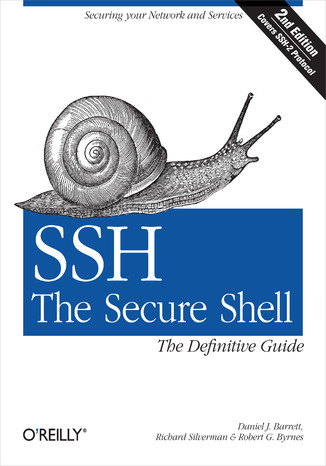



- Autorzy:
- Daniel J. Barrett, Richard E. Silverman, Robert G. Byrnes
- Ocena:
- Bądź pierwszym, który oceni tę książkę
- Stron:
- 670
- Dostępne formaty:
-
ePubMobi
 opcje wysyłki »
opcje wysyłki »
Opis
książki
:
SSH, The Secure Shell: The Definitive Guide. The Definitive Guide. 2nd Edition
Are you serious about network security? Then check out SSH, the Secure Shell, which provides key-based authentication and transparent encryption for your network connections. It's reliable, robust, and reasonably easy to use, and both free and commercial implementations are widely available for most operating systems. While it doesn't solve every privacy and security problem, SSH eliminates several of them very effectively.Everything you want to know about SSH is in our second edition of SSH, The Secure Shell: The Definitive Guide. This updated book thoroughly covers the latest SSH-2 protocol for system administrators and end users interested in using this increasingly popular TCP/IP-based solution.How does it work? Whenever data is sent to the network, SSH automatically encrypts it. When data reaches its intended recipient, SSH decrypts it. The result is "transparent" encryption-users can work normally, unaware that their communications are already encrypted. SSH supports secure file transfer between computers, secure remote logins, and a unique "tunneling" capability that adds encryption to otherwise insecure network applications. With SSH, users can freely navigate the Internet, and system administrators can secure their networks or perform remote administration.Written for a wide, technical audience, SSH, The Secure Shell: The Definitive Guide covers several implementations of SSH for different operating systems and computing environments. Whether you're an individual running Linux machines at home, a corporate network administrator with thousands of users, or a PC/Mac owner who just wants a secure way to telnet or transfer files between machines, our indispensable guide has you covered. It starts with simple installation and use of SSH, and works its way to in-depth case studies on large, sensitive computer networks.No matter where or how you're shipping information, SSH, The Secure Shell: The Definitive Guide will show you how to do it securely.
Wybrane bestsellery
-
Nowość Promocja
 Oddajemy Czytelnikowi nowe, zaktualizowane i uzupełnione wydanie książki prezentującej możliwości Kali Linux w zakresie testowania bezpieczeństwa oprogramowania. Poza opisem samego systemu i dostępnych narzędzi w wyczerpujący sposób przedstawiono tu szczegóły prowadzenia testów bezpieczeństwa, w tym sieci bezprzewodowych. Omówiono zasady testowania aplikacji WWW, techniki łamania haseł i korzystania z eksploitów. W tym wydaniu znalazły się również bezcenne wskazówki dotyczące analizy oprogramowania z wykorzystaniem inżynierii wstecznej i śledzenia nadużyć cyfrowych. Nie zabrakło też kluczowych dla każdego pentestera kwestii etyki i legalności podejmowanych działań.
Oddajemy Czytelnikowi nowe, zaktualizowane i uzupełnione wydanie książki prezentującej możliwości Kali Linux w zakresie testowania bezpieczeństwa oprogramowania. Poza opisem samego systemu i dostępnych narzędzi w wyczerpujący sposób przedstawiono tu szczegóły prowadzenia testów bezpieczeństwa, w tym sieci bezprzewodowych. Omówiono zasady testowania aplikacji WWW, techniki łamania haseł i korzystania z eksploitów. W tym wydaniu znalazły się również bezcenne wskazówki dotyczące analizy oprogramowania z wykorzystaniem inżynierii wstecznej i śledzenia nadużyć cyfrowych. Nie zabrakło też kluczowych dla każdego pentestera kwestii etyki i legalności podejmowanych działań.- PDF + ePub + Mobi
- Druk 59 pkt
(59,50 zł najniższa cena z 30 dni)
59.50 zł
119.00 zł (-50%) -
Nowość Promocja
 Jeśli chodzi o cyberbezpieczeństwo, żadna firma nie jest bezpieczna. Pytanie, które należy sobie zadać, nie brzmi: czy zostaniemy zaatakowani? Odpowiedź na nie jest bowiem oczywista: tak, zostaniecie zaatakowani. Właściwe pytania są takie: Skąd będziemy wiedzieć, że zostaliśmy zaatakowani? Co wówczas zrobimy?
Jeśli chodzi o cyberbezpieczeństwo, żadna firma nie jest bezpieczna. Pytanie, które należy sobie zadać, nie brzmi: czy zostaniemy zaatakowani? Odpowiedź na nie jest bowiem oczywista: tak, zostaniecie zaatakowani. Właściwe pytania są takie: Skąd będziemy wiedzieć, że zostaliśmy zaatakowani? Co wówczas zrobimy?- PDF + ePub + Mobi
- Druk 39 pkt
(39,50 zł najniższa cena z 30 dni)
39.50 zł
79.00 zł (-50%) -
Promocja
 Czy wiesz, co trzeba zrobić, aby odkryć ukryte słabości aplikacji i sprawdzić, jak naprawdę wygląda bezpieczeństwo w Internecie? Tu z pomocą przychodzi Burp Suite, jedno z najważniejszych narzędzi w testach penetracyjnych, które od lat wyznacza standard w cyberbezpieczeństwie. Dzięki swojej kompleksowości pozwala nie tylko przechwytywać i modyfikować ruch HTTP, ale także wykrywać podatności i wykonywać ręczne ataki. To właśnie od Burp Suite zaczyna większość osób, które marzą o karierze pentestera i chcą poznać tajniki etycznego hakingu. Darmowa wersja Community daje każdemu możliwość nauki na realnych podatnych aplikacjach. Narzędzie oferuje funkcje przydatne zarówno początkującym, jak i ekspertom – od prostych testów po metody brute force i analizę podatności z listy OWASP Top 10. Ci, którzy chcą potwierdzić swoje wysokie kompetencje, mogą podejść do prestiżowego egzaminu Burp Suite Certified Practitioner, znanego z wysokiego poziomu trudności. Burp Suite znajduje zastosowanie nie tylko w testowaniu aplikacji webowych, ale także w rozwiązaniach IoT korzystających z protokołu HTTP. Dzięki temu stał się niezbędnym elementem warsztatu każdego specjalisty do spraw bezpieczeństwa. Jeśli chcesz wejść do świata pentestów i praktycznie poznawać podatności, Burp Suite będzie Twoim najlepszym przewodnikiem.
Czy wiesz, co trzeba zrobić, aby odkryć ukryte słabości aplikacji i sprawdzić, jak naprawdę wygląda bezpieczeństwo w Internecie? Tu z pomocą przychodzi Burp Suite, jedno z najważniejszych narzędzi w testach penetracyjnych, które od lat wyznacza standard w cyberbezpieczeństwie. Dzięki swojej kompleksowości pozwala nie tylko przechwytywać i modyfikować ruch HTTP, ale także wykrywać podatności i wykonywać ręczne ataki. To właśnie od Burp Suite zaczyna większość osób, które marzą o karierze pentestera i chcą poznać tajniki etycznego hakingu. Darmowa wersja Community daje każdemu możliwość nauki na realnych podatnych aplikacjach. Narzędzie oferuje funkcje przydatne zarówno początkującym, jak i ekspertom – od prostych testów po metody brute force i analizę podatności z listy OWASP Top 10. Ci, którzy chcą potwierdzić swoje wysokie kompetencje, mogą podejść do prestiżowego egzaminu Burp Suite Certified Practitioner, znanego z wysokiego poziomu trudności. Burp Suite znajduje zastosowanie nie tylko w testowaniu aplikacji webowych, ale także w rozwiązaniach IoT korzystających z protokołu HTTP. Dzięki temu stał się niezbędnym elementem warsztatu każdego specjalisty do spraw bezpieczeństwa. Jeśli chcesz wejść do świata pentestów i praktycznie poznawać podatności, Burp Suite będzie Twoim najlepszym przewodnikiem.- Videokurs 50 pkt
(90,29 zł najniższa cena z 30 dni)
50.00 zł
129.00 zł (-61%) -
Promocja
 Dzięki tej książce nauczysz się skutecznie wykrywać cyberataki wymierzone w infrastrukturę opartą na systemie Windows i dowiesz się, jak na nie reagować. Zaczniesz od zapoznania się ze współczesnymi technikami cyberataków, z metodami działania napastników i ich motywacjami. Poznasz szczegóły każdej fazy procesu reagowania — od wykrycia, przez analizę, aż po odzyskiwanie danych — a także niezbędne narzędzia, techniki i strategie. W miarę postępów zgłębisz tajniki odnajdywania cyfrowych śladów na endpointach. Na koniec przeanalizujesz sprawdzone podejścia do wykrywania zagrożeń i poznasz strategie aktywnej detekcji incydentów, jeszcze zanim agresor osiągnie swój cel.
Dzięki tej książce nauczysz się skutecznie wykrywać cyberataki wymierzone w infrastrukturę opartą na systemie Windows i dowiesz się, jak na nie reagować. Zaczniesz od zapoznania się ze współczesnymi technikami cyberataków, z metodami działania napastników i ich motywacjami. Poznasz szczegóły każdej fazy procesu reagowania — od wykrycia, przez analizę, aż po odzyskiwanie danych — a także niezbędne narzędzia, techniki i strategie. W miarę postępów zgłębisz tajniki odnajdywania cyfrowych śladów na endpointach. Na koniec przeanalizujesz sprawdzone podejścia do wykrywania zagrożeń i poznasz strategie aktywnej detekcji incydentów, jeszcze zanim agresor osiągnie swój cel.- PDF + ePub + Mobi
- Druk 38 pkt
(38,50 zł najniższa cena z 30 dni)
38.50 zł
77.00 zł (-50%) -
Promocja
 Książka, którą trzymasz w rękach, powstała z potrzeby zebrania w jednym miejscu najważniejszych zagadnień dotyczących sieci komputerowych i przedstawienia tej wiedzy w formie przystępnych odpowiedzi na konkretne pytania. Ten praktyczny przewodnik krok po kroku przeprowadzi Cię przez fundamenty działania współczesnych sieci komputerowych z uwzględnieniem ewolucji technologii, najlepszych praktyk, a także rzeczywistych scenariuszy stosowanych przez administratorów. Planujesz karierę jako inżynier sieci? Koniecznie sięgnij po tę książkę. Przy czym skorzystają z niej nie tylko przyszli inżynierowie - również pasjonaci sieci, studenci kierunków technicznych, specjaliści IT i osoby przygotowujące się do certyfikacji znajdą tu wiele cennych informacji.
Książka, którą trzymasz w rękach, powstała z potrzeby zebrania w jednym miejscu najważniejszych zagadnień dotyczących sieci komputerowych i przedstawienia tej wiedzy w formie przystępnych odpowiedzi na konkretne pytania. Ten praktyczny przewodnik krok po kroku przeprowadzi Cię przez fundamenty działania współczesnych sieci komputerowych z uwzględnieniem ewolucji technologii, najlepszych praktyk, a także rzeczywistych scenariuszy stosowanych przez administratorów. Planujesz karierę jako inżynier sieci? Koniecznie sięgnij po tę książkę. Przy czym skorzystają z niej nie tylko przyszli inżynierowie - również pasjonaci sieci, studenci kierunków technicznych, specjaliści IT i osoby przygotowujące się do certyfikacji znajdą tu wiele cennych informacji.- PDF + ePub + Mobi
- Druk 44 pkt
(44,50 zł najniższa cena z 30 dni)
44.50 zł
89.00 zł (-50%) -
Promocja
 W realiach, w których hakerzy nieustannie adaptują metody pozyskiwania danych w nieautoryzowany sposób, aktualna wiedza i praktyka w zakresie cyberbezpieczeństwa są niezbędne. Szczególnie warto zwrócić uwagę na bezpieczeństwo w chmurze. Ponad 90 procent ataków na środowiska cloudowe wynika z błędnej konfiguracji tożsamości i uprawnień, co czyni Entra ID i Microsoft 365 krytycznymi obszarami do zabezpieczenia. Umiejętność wykrywania luk typu brak MFA czy błędne linki udostępniania w SharePoint pozwala nie tylko chronić firmowe dane, ale również zapobiegać potencjalnym stratom finansowym i wizerunkowym. Narzędzia używane przez pentesterów, takie jak BloodHound, GraphRunner i TokenTactics, umożliwiają symulowanie rzeczywistych ataków i analizę wewnętrznych relacji uprawnień, niedostrzegalnych na pierwszy rzut oka. Automatyzacja z Azure Runbook czy Omnispray, w połączeniu ze znajomością tokenów JWT, a także technik ataków password spray i token replay, pozwala lepiej zrozumieć skalę współczesnych zagrożeń i skutecznie zabezpieczać aplikacje i konta użytkowników. Aktualną wiedzę o cloud security znajdziesz w naszym szkoleniu. W dobie powszechnej migracji do chmury jej ochrona przestaje być opcją, a staje się obowiązkiem. Jednocześnie wiedza z tego zakresu otwiera nowe perspektywy zawodowe w red teams, blue teams, jak również działach compliance.
W realiach, w których hakerzy nieustannie adaptują metody pozyskiwania danych w nieautoryzowany sposób, aktualna wiedza i praktyka w zakresie cyberbezpieczeństwa są niezbędne. Szczególnie warto zwrócić uwagę na bezpieczeństwo w chmurze. Ponad 90 procent ataków na środowiska cloudowe wynika z błędnej konfiguracji tożsamości i uprawnień, co czyni Entra ID i Microsoft 365 krytycznymi obszarami do zabezpieczenia. Umiejętność wykrywania luk typu brak MFA czy błędne linki udostępniania w SharePoint pozwala nie tylko chronić firmowe dane, ale również zapobiegać potencjalnym stratom finansowym i wizerunkowym. Narzędzia używane przez pentesterów, takie jak BloodHound, GraphRunner i TokenTactics, umożliwiają symulowanie rzeczywistych ataków i analizę wewnętrznych relacji uprawnień, niedostrzegalnych na pierwszy rzut oka. Automatyzacja z Azure Runbook czy Omnispray, w połączeniu ze znajomością tokenów JWT, a także technik ataków password spray i token replay, pozwala lepiej zrozumieć skalę współczesnych zagrożeń i skutecznie zabezpieczać aplikacje i konta użytkowników. Aktualną wiedzę o cloud security znajdziesz w naszym szkoleniu. W dobie powszechnej migracji do chmury jej ochrona przestaje być opcją, a staje się obowiązkiem. Jednocześnie wiedza z tego zakresu otwiera nowe perspektywy zawodowe w red teams, blue teams, jak również działach compliance.- Videokurs 50 pkt
(39,90 zł najniższa cena z 30 dni)
50.00 zł
119.00 zł (-58%) -
Promocja
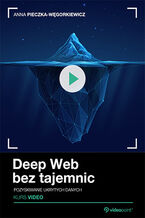 Deep Web to ogromna, ukryta część Internetu, która pozostaje niewidoczna dla tradycyjnych wyszukiwarek takich jak Google. Obejmuje zasoby nieindeksowane przez standardowe boty – bazy danych, repozytoria naukowe, archiwa statystyczne czy wyspecjalizowane wyszukiwarki branżowe. W przeciwieństwie do Dark Webu, Deep Web nie jest anonimową przestrzenią przestępczą, lecz miejscem dostępu do wartościowych i często darmowych informacji. Znajomość Deep Webu pozwala dotrzeć do wiarygodnych źródeł danych z zakresu demografii, zdrowia, edukacji, środowiska czy gospodarki. To również nieocenione narzędzie dla analityków, dziennikarzy, badaczy i osób podejmujących decyzje na podstawie twardych danych.
Deep Web to ogromna, ukryta część Internetu, która pozostaje niewidoczna dla tradycyjnych wyszukiwarek takich jak Google. Obejmuje zasoby nieindeksowane przez standardowe boty – bazy danych, repozytoria naukowe, archiwa statystyczne czy wyspecjalizowane wyszukiwarki branżowe. W przeciwieństwie do Dark Webu, Deep Web nie jest anonimową przestrzenią przestępczą, lecz miejscem dostępu do wartościowych i często darmowych informacji. Znajomość Deep Webu pozwala dotrzeć do wiarygodnych źródeł danych z zakresu demografii, zdrowia, edukacji, środowiska czy gospodarki. To również nieocenione narzędzie dla analityków, dziennikarzy, badaczy i osób podejmujących decyzje na podstawie twardych danych.- Videokurs 39 pkt
(34,90 zł najniższa cena z 30 dni)
39.90 zł
199.00 zł (-80%) -
Promocja
 The CEH exam is not an enjoyable undertaking. This grueling, exhaustive, challenging, and taxing exam will either leave you better prepared to be the best cyber security professional you can be. But preparing for the exam itself needn't be that way. In this book, IT security and education professional Matt Walker will not only guide you through ev
The CEH exam is not an enjoyable undertaking. This grueling, exhaustive, challenging, and taxing exam will either leave you better prepared to be the best cyber security professional you can be. But preparing for the exam itself needn't be that way. In this book, IT security and education professional Matt Walker will not only guide you through ev-
- ePub + Mobi 186 pkt
(29,90 zł najniższa cena z 30 dni)
186.15 zł
219.00 zł (-15%) -
-
Promocja
 Tę książkę docenią specjaliści do spraw cyberbezpieczeństwa, którzy chcą zdobyć umiejętności zabezpieczania systemów AI. Znajdą w niej uporządkowaną prezentację wyników badań i najnowszych standardów branżowych, z uwzględnieniem klasyfikacji: MITRE, NIST i OWASP. W przewodniku omówiono strategię zabezpieczania AI już na etapie projektowania ― z wykorzystaniem modelowania zagrożeń, przy czym skoncentrowano się na integracji MLSecOps i LLMOps z systemami bezpieczeństwa przedsiębiorstwa. Dodatkowo przedstawiono przykłady wdrażania integracji ciągłej, strategii i narzędzi MLOps, a także mechanizmów kontroli bezpieczeństwa. Zaproponowano ponadto bazujący na klasycznych filarach NIST plan wzmacniania bezpieczeństwa AI w przedsiębiorstwie.
Tę książkę docenią specjaliści do spraw cyberbezpieczeństwa, którzy chcą zdobyć umiejętności zabezpieczania systemów AI. Znajdą w niej uporządkowaną prezentację wyników badań i najnowszych standardów branżowych, z uwzględnieniem klasyfikacji: MITRE, NIST i OWASP. W przewodniku omówiono strategię zabezpieczania AI już na etapie projektowania ― z wykorzystaniem modelowania zagrożeń, przy czym skoncentrowano się na integracji MLSecOps i LLMOps z systemami bezpieczeństwa przedsiębiorstwa. Dodatkowo przedstawiono przykłady wdrażania integracji ciągłej, strategii i narzędzi MLOps, a także mechanizmów kontroli bezpieczeństwa. Zaproponowano ponadto bazujący na klasycznych filarach NIST plan wzmacniania bezpieczeństwa AI w przedsiębiorstwie.- PDF + ePub + Mobi
- Druk 64 pkt
(64,50 zł najniższa cena z 30 dni)
64.50 zł
129.00 zł (-50%) -
Promocja
 Cechą dzisiejszego rynku IT jest ciągła zmiana. Zmieniają się urządzenia, modyfikacjom podlega również software. Jedną z przyczyn wprowadzania kolejnych unowocześnień jest dążenie do utrzymania odpowiedniego poziomu świadczenia usług biznesowych i wysokiego poziomu bezpieczeństwa. Służy temu na przykład zastosowanie monitoringu infrastruktury, czyli użycie odpowiednich narzędzi weryfikujących stan sieci, serwerów czy też aplikacji.
Cechą dzisiejszego rynku IT jest ciągła zmiana. Zmieniają się urządzenia, modyfikacjom podlega również software. Jedną z przyczyn wprowadzania kolejnych unowocześnień jest dążenie do utrzymania odpowiedniego poziomu świadczenia usług biznesowych i wysokiego poziomu bezpieczeństwa. Służy temu na przykład zastosowanie monitoringu infrastruktury, czyli użycie odpowiednich narzędzi weryfikujących stan sieci, serwerów czy też aplikacji.- PDF + ePub + Mobi
- Druk 34 pkt
(34,50 zł najniższa cena z 30 dni)
34.50 zł
69.00 zł (-50%)
O autorze książki
Dr Daniel J. Barrett jest inżynierem oprogramowania, administratorem systemów, muzykiem i satyrykiem. Od wczesnych lat 90. XX wieku pisze o technologiach informatycznych. Dla wydawnictwa O’Reilly napisał wiele książek, między innymi: SSH, Secure Shell: The Definitive Guide, MediaWiki i Linux. Bezpieczeństwo. Receptury.
Daniel J. Barrett, Richard E. Silverman, Robert G. Byrnes - pozostałe książki
-
Promocja
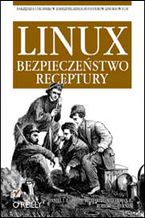 Książka "Linux. Bezpieczeństwo. Przewodnik encyklopedyczny" nauczy Cię, jakie polecenia należy wykonać i co wpisać w plikach konfiguracyjnych, by poprawić bezpieczeństwo Twojego systemu. Nie jest to klasyczny podręcznik; nie znajdziesz tu teorii, lecz rozwiązania konkretnych problemów i sposoby łatania typowych luk w zabezpieczeniach. Dzięki książce nie będziesz tracić cennego czasu, poszukując właściwej składni poleceń. Przeznaczona jest dla średnio zaawansowanych użytkowników i administratorów systemów Linux.
Książka "Linux. Bezpieczeństwo. Przewodnik encyklopedyczny" nauczy Cię, jakie polecenia należy wykonać i co wpisać w plikach konfiguracyjnych, by poprawić bezpieczeństwo Twojego systemu. Nie jest to klasyczny podręcznik; nie znajdziesz tu teorii, lecz rozwiązania konkretnych problemów i sposoby łatania typowych luk w zabezpieczeniach. Dzięki książce nie będziesz tracić cennego czasu, poszukując właściwej składni poleceń. Przeznaczona jest dla średnio zaawansowanych użytkowników i administratorów systemów Linux.- Druk 44 pkt
(41,40 zł najniższa cena z 30 dni)
44.85 zł
69.00 zł (-35%) -
Promocja
 Computer security is an ongoing process, a relentless contest between system administrators and intruders. A good administrator needs to stay one step ahead of any adversaries, which often involves a continuing process of education. If you're grounded in the basics of security, however, you won't necessarily want a complete treatise on the subject
Computer security is an ongoing process, a relentless contest between system administrators and intruders. A good administrator needs to stay one step ahead of any adversaries, which often involves a continuing process of education. If you're grounded in the basics of security, however, you won't necessarily want a complete treatise on the subject-
- ePub + Mobi 109 pkt
(29,90 zł najniższa cena z 30 dni)
109.65 zł
129.00 zł (-15%) -
-
Promocja
 Administratorzy systemów linuksowych mogą pracować za pomocą myszy, korzystając z interfejsu graficznego, jednak pełny potencjał Linuksa ujawnia się dzięki pracy z wierszem poleceń. Umiejętność używania tego narzędzia przydaje się każdemu, komu zależy na efektywnym działaniu systemu.
Administratorzy systemów linuksowych mogą pracować za pomocą myszy, korzystając z interfejsu graficznego, jednak pełny potencjał Linuksa ujawnia się dzięki pracy z wierszem poleceń. Umiejętność używania tego narzędzia przydaje się każdemu, komu zależy na efektywnym działaniu systemu.- PDF + ePub + Mobi
- Druk 29 pkt
(29,95 zł najniższa cena z 30 dni)
29.95 zł
59.90 zł (-50%) -
Promocja
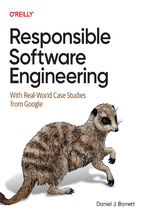 Today's software applications need more than a friendly interface and correct algorithms. They also need to be responsible: to be beneficial for society and not cause harm. In an era of AI chatbots, deep fake images and videos, social media bubbles, expanding privacy regulations, and a warming planet, it's more important than ever to practice respo
Today's software applications need more than a friendly interface and correct algorithms. They also need to be responsible: to be beneficial for society and not cause harm. In an era of AI chatbots, deep fake images and videos, social media bubbles, expanding privacy regulations, and a warming planet, it's more important than ever to practice respo-
- ePub + Mobi 169 pkt
(29,90 zł najniższa cena z 30 dni)
169.14 zł
199.00 zł (-15%) -
-
Promocja
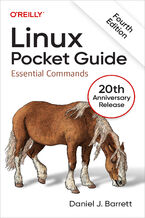 If you use Linux in your day-to-day work, then Linux Pocket Guide is the perfect on-the-job reference. This thoroughly updated 20th anniversary edition explains more than 200 Linux commands, including new commands for file handling, package management, version control, file format conversions, and more.In this concise guide, author Daniel Barrett p
If you use Linux in your day-to-day work, then Linux Pocket Guide is the perfect on-the-job reference. This thoroughly updated 20th anniversary edition explains more than 200 Linux commands, including new commands for file handling, package management, version control, file format conversions, and more.In this concise guide, author Daniel Barrett p-
- ePub + Mobi 84 pkt
(29,90 zł najniższa cena z 30 dni)
84.92 zł
99.90 zł (-15%) -
-
Promocja
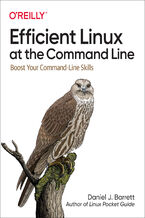 Take your Linux skills to the next level! Whether you're a system administrator, software developer, site reliability engineer, or enthusiastic hobbyist, this practical, hands-on book will help you work faster, smarter, and more efficiently. You'll learn how to create and run complex commands that solve real business problems, process and retrieve
Take your Linux skills to the next level! Whether you're a system administrator, software developer, site reliability engineer, or enthusiastic hobbyist, this practical, hands-on book will help you work faster, smarter, and more efficiently. You'll learn how to create and run complex commands that solve real business problems, process and retrieve-
- ePub + Mobi 160 pkt
(29,90 zł najniższa cena z 30 dni)
160.65 zł
189.00 zł (-15%) -
-
Promocja
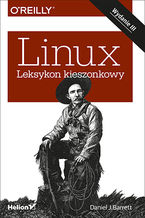 Niniejsza książka jest zwięzłym przewodnikiem po systemie. Docenią ją zarówno początkujący, jak i zaawansowani użytkownicy. Opisano tu ważne i użyteczne aspekty Linuksa, tak aby każdy szybko mógł rozpocząć efektywną pracę. W tym wydaniu książki pojawiły się również nowe polecenia służące do przetwarzania plików audiowizualnych, odczytywania i zapisywania zawartości schowka systemowego oraz do wykonywania operacji na plikach PDF. Nie pominięto też idiomów powłoki, takich jak podstawianie poleceń czy przekazywanie ich potokiem do powłoki.
Niniejsza książka jest zwięzłym przewodnikiem po systemie. Docenią ją zarówno początkujący, jak i zaawansowani użytkownicy. Opisano tu ważne i użyteczne aspekty Linuksa, tak aby każdy szybko mógł rozpocząć efektywną pracę. W tym wydaniu książki pojawiły się również nowe polecenia służące do przetwarzania plików audiowizualnych, odczytywania i zapisywania zawartości schowka systemowego oraz do wykonywania operacji na plikach PDF. Nie pominięto też idiomów powłoki, takich jak podstawianie poleceń czy przekazywanie ich potokiem do powłoki.- PDF + ePub + Mobi
- Druk 14 pkt
(14,95 zł najniższa cena z 30 dni)
14.95 zł
29.90 zł (-50%) -
Promocja
 Jeśli chciałbyś zgłębić system Git, trafiłeś na doskonałą książkę. Dzięki jej niewielkim rozmiarom możesz mieć ją zawsze przy sobie. Zmiana SVN na Git oprócz poznania nowych pojęć wymaga zmiany sposobu myślenia. Ten leksykon pozwoli Ci w każdej chwili sprawdzić, jak stworzyć nowe repozytorium czy gałąź oraz jak wprowadzić zmiany i przesłać je na centralny serwer. Ponadto dowiesz się, jak śledzić zdalne repozytoria, przeglądać historię zmian i scalać wersje. To doskonała lektura dla wszystkich osób chcących błyskawicznie poznać możliwości Gita i zacząć stosować go w codziennej pracy.
Jeśli chciałbyś zgłębić system Git, trafiłeś na doskonałą książkę. Dzięki jej niewielkim rozmiarom możesz mieć ją zawsze przy sobie. Zmiana SVN na Git oprócz poznania nowych pojęć wymaga zmiany sposobu myślenia. Ten leksykon pozwoli Ci w każdej chwili sprawdzić, jak stworzyć nowe repozytorium czy gałąź oraz jak wprowadzić zmiany i przesłać je na centralny serwer. Ponadto dowiesz się, jak śledzić zdalne repozytoria, przeglądać historię zmian i scalać wersje. To doskonała lektura dla wszystkich osób chcących błyskawicznie poznać możliwości Gita i zacząć stosować go w codziennej pracy.- PDF + ePub + Mobi
- Druk 14 pkt
(14,95 zł najniższa cena z 30 dni)
14.95 zł
29.90 zł (-50%) -
Promocja
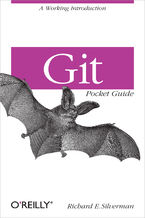 This pocket guide is the perfect on-the-job companion to Git, the distributed version control system. It provides a compact, readable introduction to Git for new users, as well as a reference to common commands and procedures for those of you with Git experience.Written for Git version 1.8.2, this handy task-oriented guide is organized around the b
This pocket guide is the perfect on-the-job companion to Git, the distributed version control system. It provides a compact, readable introduction to Git for new users, as well as a reference to common commands and procedures for those of you with Git experience.Written for Git version 1.8.2, this handy task-oriented guide is organized around the b-
- ePub + Mobi 42 pkt
(29,90 zł najniższa cena z 30 dni)
42.42 zł
49.90 zł (-15%) -
Ebooka "SSH, The Secure Shell: The Definitive Guide. The Definitive Guide. 2nd Edition" przeczytasz na:
-
czytnikach Inkbook, Kindle, Pocketbook, Onyx Boox i innych
-
systemach Windows, MacOS i innych
-
systemach Windows, Android, iOS, HarmonyOS
-
na dowolnych urządzeniach i aplikacjach obsługujących formaty: PDF, EPub, Mobi
Masz pytania? Zajrzyj do zakładki Pomoc »
Szczegóły książki
- ISBN Ebooka:
- 978-14-493-2481-0, 9781449324810
- Data wydania ebooka :
-
2005-05-10
 Data wydania ebooka często jest dniem wprowadzenia tytułu do sprzedaży i może nie być równoznaczna
z datą wydania książki papierowej. Dodatkowe informacje możesz znaleźć w darmowym fragmencie.
Jeśli masz wątpliwości skontaktuj się z nami sklep@ebookpoint.pl.
Data wydania ebooka często jest dniem wprowadzenia tytułu do sprzedaży i może nie być równoznaczna
z datą wydania książki papierowej. Dodatkowe informacje możesz znaleźć w darmowym fragmencie.
Jeśli masz wątpliwości skontaktuj się z nami sklep@ebookpoint.pl.
- Język publikacji:
- angielski
- Rozmiar pliku ePub:
- 3.5MB
- Rozmiar pliku Mobi:
- 7.8MB
Dostępność produktu
Produkt nie został jeszcze oceniony pod kątem ułatwień dostępu lub nie podano żadnych informacji o ułatwieniach dostępu lub są one niewystarczające. Prawdopodobnie Wydawca/Dostawca jeszcze nie umożliwił dokonania walidacji produktu lub nie przekazał odpowiednich informacji na temat jego dostępności.
Spis treści książki
- SSH, the Secure Shell, 2nd Edition
- SPECIAL OFFER: Upgrade this ebook with OReilly
- Preface
- Protect Your Network with SSH
- Intended Audience
- End-User Audience
- Prerequisites
- System-Administrator Audience
- Prerequisites
- End-User Audience
- Reading This Book
- Our Approach
- Which Chapters Are for You?
- Supported Platforms
- Disclaimers
- Conventions Used in This Book
- Comments and Questions
- Safari Enabled
- Acknowledgments
- 1. Introduction to SSH
- What Is SSH?
- What SSH Is Not
- The SSH Protocol
- 1.3.1 Protocols, Products, Clients, and Confusion
- Overview of SSH Features
- 1.4.1 Secure Remote Logins
- 1.4.2 Secure File Transfer
- 1.4.3 Secure Remote Command Execution
- 1.4.4 Keys and Agents
- 1.4.5 Access Control
- 1.4.6 Port Forwarding
- History of SSH
- Related Technologies
- 1.6.1 rsh Suite (r-Commands)
- 1.6.2 Pretty Good Privacy (PGP) and GNU Privacy Guard (GnuPG)
- 1.6.3 Kerberos
- 1.6.4 IPSEC and Virtual Private Networks
- 1.6.5 Secure Remote Password (SRP)
- 1.6.6 Secure Socket Layer (SSL) Protocol
- 1.6.7 SSL-Enhanced Telnet and FTP
- 1.6.8 stunnel
- 1.6.9 Firewalls
- Summary
- 2. Basic Client Use
- A Running Example
- Remote Terminal Sessions with ssh
- 2.2.1 File Transfer with scp
- Adding Complexity to the Example
- 2.3.1 Known Hosts
- 2.3.2 The Escape Character
- Authentication by Cryptographic Key
- 2.4.1 A Brief Introduction to Keys
- 2.4.2 Generating Key Pairs with ssh-keygen
- 2.4.3 Installing a Public Key on an SSH Server Machine
- 2.4.3.1 Instructions for OpenSSH
- 2.4.3.2 Instructions for Tectia
- 2.4.4 If You Change Your Key
- The SSH Agent
- 2.5.1 Agents and Automation
- 2.5.2 A More Complex Passphrase Problem
- 2.5.3 Agent Forwarding
- Connecting Without a Password or Passphrase
- Miscellaneous Clients
- 2.7.1 sftp
- 2.7.2 slogin
- Summary
- 3. Inside SSH
- Overview of Features
- 3.1.1 Privacy (Encryption)
- 3.1.2 Integrity
- 3.1.3 Authentication
- 3.1.4 Authorization
- 3.1.5 Forwarding (Tunneling)
- A Cryptography Primer
- 3.2.1 How Secure Is Secure?
- 3.2.2 Public-and Secret-Key Cryptography
- 3.2.3 Hash Functions
- The Architecture of an SSH System
- Inside SSH-2
- 3.4.1 Protocol Summary
- 3.4.2 SSH Transport Layer Protocol (SSH-TRANS)
- 3.4.2.1 Connection
- 3.4.2.2 Protocol version selection
- 3.4.2.3 Parameter negotiation
- 3.4.2.4 Key exchange and server authentication
- 3.4.2.5 Server authentication and antispoofing: some gory details
- 3.4.2.6 Wonder security powers, activate!
- 3.4.3 SSH Authentication Protocol (SSH-AUTH)
- 3.4.3.1 The authentication request
- 3.4.3.2 The authentication response
- 3.4.3.3 Getting started: the "none" request
- 3.4.3.4 Public-key authentication
- 3.4.3.5 Password authentication
- 3.4.3.6 Hostbased authentication
- 3.4.4 SSH Connection Protocol (SSH-CONN)
- 3.4.4.1 Channels
- 3.4.4.2 Requests
- 3.4.4.3 The finish line
- Inside SSH-1
- Implementation Issues
- 3.6.1 Host Keys
- 3.6.2 Authorization in Hostbased Authentication
- 3.6.2.1 Hostbased access files
- 3.6.2.2 Control file details
- 3.6.2.3 Netgroups as wildcards
- 3.6.2.4 Summary
- 3.6.3 SSH-1 Backward Compatibility
- 3.6.4 Randomness
- 3.6.5 Privilege Separation in OpenSSH
- SSH and File Transfers (scp and sftp)
- 3.7.1 Whats in a Name?
- 3.7.2 scp Details
- 3.7.3 scp2/sftp Details
- Algorithms Used by SSH
- 3.8.1 Public-Key Algorithms
- 3.8.1.1 Rivest-Shamir-Adleman (RSA)
- 3.8.1.2 Digital Signature Algorithm (DSA)
- 3.8.1.3 Diffie-Hellman key agreement
- 3.8.2 Secret-Key Algorithms
- 3.8.2.1 International Data Encryption Algorithm (IDEA)
- 3.8.2.2 Advanced Encryption Standard (AES)
- 3.8.2.3 Data Encryption Standard (DES)
- 3.8.2.4 Triple-DES
- 3.8.2.5 ARCFOUR (RC4)
- 3.8.2.6 Blowfish
- 3.8.2.7 Twofish
- 3.8.2.8 CAST
- 3.8.3 Hash Functions
- 3.8.3.1 CRC-32
- 3.8.3.2 MD5
- 3.8.3.3 SHA-1
- 3.8.3.4 RIPEMD-160
- 3.8.4 Compression Algorithms: zlib
- 3.8.1 Public-Key Algorithms
- Threats SSH Can Counter
- 3.9.1 Eavesdropping
- 3.9.2 Name Service and IP Spoofing
- 3.9.3 Connection Hijacking
- 3.9.4 Man-in-the-Middle Attacks
- Threats SSH Doesn't Prevent
- 3.10.1 Password Cracking
- 3.10.2 IP and TCP Attacks
- 3.10.3 Traffic Analysis
- 3.10.4 Covert Channels
- 3.10.5 Carelessness
- Threats Caused by SSH
- Summary
- Overview of Features
- 4. Installation and Compile-Time Configuration
- Overview
- 4.1.1 Install the Prerequisites
- 4.1.2 Obtain the Sources
- 4.1.3 Verify the Signature
- 4.1.4 Extract the Source Files
- 4.1.5 Perform Compile-Time Configuration
- 4.1.6 Compile Everything
- 4.1.7 Install the Programs and Configuration Files
- Installing OpenSSH
- 4.2.1 Prerequisites
- 4.2.2 Downloading and Extracting the Files
- 4.2.2.1 Verifying with GnuPG
- 4.2.3 Building and Installing
- 4.2.4 Configuration Options
- 4.2.4.1 File locations
- 4.2.4.2 Random number generation
- 4.2.4.3 Networking
- 4.2.4.4 Authentication
- 4.2.4.5 Access control
- Installing Tectia
- 4.3.1 Prerequisites
- 4.3.2 Obtaining and Extracting the Files
- 4.3.3 Verifying with md5sum
- 4.3.4 Building and Installing
- 4.3.5 Configuration Options
- 4.3.5.1 File locations and permission
- 4.3.5.2 Random number generation
- 4.3.5.3 Networking
- 4.3.5.4 X Window System
- 4.3.5.5 TCP port forwarding
- 4.3.5.6 Encryption
- 4.3.5.7 Authentication
- 4.3.5.8 SOCKS proxies
- 4.3.5.9 Debugging
- 4.3.5.10 SSH-1 protocol compatibility
- 4.3.6 SSH-1 Compatibility Support for Tectia
- Software Inventory
- Replacing r-Commands with SSH
- 4.5.1 Concurrent Versions System (CVS)
- 4.5.2 GNU Emacs
- 4.5.3 Pine
- 4.5.4 rsync, rdist
- Summary
- Overview
- 5. Serverwide Configuration
- Running the Server
- 5.1.1 Running sshd as the Superuser
- 5.1.2 Running sshd as an Ordinary User
- Server Configuration: An Overview
- 5.2.1 Server Configuration Files
- 5.2.2 Checking Configuration Files
- 5.2.2.1 Checking OpenSSH configuration files
- 5.2.2.2 Checking Tectia configuration files
- 5.2.3 Command-Line Options
- 5.2.4 Changing the Configuration
- 5.2.5 A Tricky Reconfiguration Example
- Getting Ready: Initial Setup
- 5.3.1 File Locations
- 5.3.1.1 Host key files
- 5.3.1.2 Random seed file
- 5.3.1.3 Process ID file
- 5.3.1.4 Server configuration file
- 5.3.1.5 User SSH directory
- 5.3.1.6 Per-account authorization files
- 5.3.1.7 utmp file structure
- 5.3.2 File Permissions
- 5.3.2.1 Acceptable permissions for user files
- 5.3.3 TCP/IP Settings
- 5.3.3.1 Port number and network interface
- 5.3.3.2 Invocation by inetd or xinetd
- 5.3.3.3 Restarting the SSH server for each connection
- 5.3.3.4 Keepalive messages
- 5.3.3.5 Idle connections
- 5.3.3.6 Failed logins
- 5.3.3.7 Limiting simultaneous connections
- 5.3.3.8 Reverse IP mappings
- 5.3.3.9 Controlling the Nagle Algorithm
- 5.3.3.10 Discovering other servers
- 5.3.4 Key Regeneration
- 5.3.5 Encryption Algorithms
- 5.3.6 Integrity-Checking (MAC) Algorithms
- 5.3.7 SSH Protocol Settings
- 5.3.7.1 Protocol version string
- 5.3.8 Compression
- 5.3.1 File Locations
- Authentication: Verifying Identities
- 5.4.1 Authentication Syntax
- 5.4.2 Password Authentication
- 5.4.2.1 Failed password attempts
- 5.4.2.2 Empty passwords
- 5.4.2.3 Expired passwords
- 5.4.3 Public-Key Authentication
- 5.4.4 Hostbased Authentication
- 5.4.5 Keyboard-Interactive Authentication
- 5.4.5.1 OpenSSH keyboard-interactive authentication
- 5.4.5.2 Tectia's keyboard-interactive authentication
- 5.4.6 PGP Authentication
- 5.4.7 Kerberos Authentication
- 5.4.7.1 Kerberos and OpenSSH
- 5.4.7.2 Kerberos and Tectia
- 5.4.8 PAM Authentication
- 5.4.9 Privilege Separation
- 5.4.10 Selecting a Login Program
- Access Control: Letting People In
- 5.5.1 Account Access Control
- 5.5.1.1 Restricting all logins
- 5.5.2 Group Access Control
- 5.5.3 Hostname Access Control
- 5.5.4 shosts Access Control
- 5.5.5 Root Access Control
- 5.5.6 External Access Control
- 5.5.7 Restricting Directory Access with chroot
- 5.5.8 Summary of Authentication and Access Control
- 5.5.1 Account Access Control
- User Logins and Accounts
- 5.6.1 Welcome Messages for the User
- 5.6.2 Setting Environment Variables
- 5.6.3 Initialization Scripts
- Forwarding
- 5.7.1 Port Forwarding
- 5.7.2 X Forwarding
- 5.7.3 Agent Forwarding
- Subsystems
- Logging and Debugging
- 5.9.1 OpenSSH Logging and Debugging
- 5.9.2 Tectia Logging and Debugging
- 5.9.3 Debugging Under inetd or xinetd
- Compatibility Between SSH-1 and SSH-2 Servers
- 5.10.1 Security Issues with Tectia's SSH-1 Compatibility Mode
- Summary
- Running the Server
- 6. Key Management and Agents
- What Is an Identity?
- 6.1.1 OpenSSH Identities
- 6.1.2 Tectia Identities
- Creating an Identity
- 6.2.1 Generating Keys for OpenSSH
- 6.2.1.1 Creating OpenSSH keys
- 6.2.1.2 Working with OpenSSH keys
- 6.2.2 Generating Keys for Tectia
- 6.2.2.1 Creating Tectia keys
- 6.2.2.2 Working with Tectia keys
- 6.2.3 Selecting a Passphrase
- 6.2.4 Generating New Groups for Diffie-Hellman Key Exchange
- 6.2.1 Generating Keys for OpenSSH
- SSH Agents
- 6.3.1 Agents Do Not Expose Keys
- 6.3.2 Starting an Agent
- 6.3.2.1 Single-shell method
- 6.3.2.2 Subshell method
- 6.3.2.3 Format of environment variable commands
- 6.3.3 Loading Keys with ssh-add
- 6.3.3.1 Automatic agent loading (single-shell method)
- 6.3.3.2 Automatic agent loading (subshell method)
- 6.3.3.3 Automatic agent loading (X Window System)
- 6.3.4 Agents and Security
- 6.3.4.1 Access control
- 6.3.4.2 Cracking an agent
- 6.3.5 Agent Forwarding
- 6.3.5.1 A firewall example
- 6.3.5.2 How agent forwarding works
- 6.3.5.3 Enabling agent forwarding
- 6.3.6 Agent CPU Usage
- 6.3.7 Debugging the Agent
- Multiple Identities
- 6.4.1 Switching Identities Manually
- 6.4.2 Switching Identities with an Agent
- 6.4.3 Tailoring Sessions Based on Identity
- PGP Authentication in Tectia
- Tectia External Keys
- Summary
- What Is an Identity?
- 7. Advanced Client Use
- How to Configure Clients
- 7.1.1 Command-Line Options
- 7.1.2 Client Configuration Files
- 7.1.2.1 Keywords versus command-line options
- 7.1.2.2 Global and local files
- 7.1.2.3 Configuration-file sections
- 7.1.2.4 Multiple matches
- 7.1.2.5 Making nicknames for hosts
- 7.1.2.6 Comments, indenting, and style
- 7.1.3 Environment Variables
- Precedence
- Introduction to Verbose Mode
- Client Configuration in Depth
- 7.4.1 Remote Account Name
- 7.4.1.1 Tricks with remote account names
- 7.4.2 User Identity
- 7.4.2.1 Using identities
- 7.4.3 Host Keys and Known-Hosts Databases
- 7.4.3.1 Strict host-key checking
- 7.4.3.2 Verifying host keys by DNS
- 7.4.3.3 Host key aliasing
- 7.4.3.4 Ignoring host keys for localhost
- 7.4.3.5 Moving the known hosts files
- 7.4.4 SSH Protocol Settings
- 7.4.4.1 Choosing a protocol version
- 7.4.4.2 Connection sharing
- 7.4.4.3 Setting environment variables in the server
- 7.4.5 TCP/IP Settings
- 7.4.5.1 Selecting a remote port
- 7.4.5.2 Connecting via a given network interface
- 7.4.5.3 Forcing a nonprivileged local port
- 7.4.5.4 Keepalive messages
- 7.4.5.5 Controlling TCP_NODELAY
- 7.4.5.6 Requiring IPv4 and IPv6
- 7.4.6 Making Connections
- 7.4.6.1 Number of connection attempts
- 7.4.6.2 Password prompting in OpenSSH
- 7.4.6.3 Password prompting in Tectia
- 7.4.6.4 Batch mode: suppressing prompts
- 7.4.6.5 Pseudo-terminal allocation (TTY/PTY/PTTY)
- 7.4.6.6 Backgrounding a remote command
- 7.4.6.7 Backgrounding a remote command, take two
- 7.4.6.8 Escaping
- 7.4.7 Proxies and SOCKS
- 7.4.7.1 SOCKS in OpenSSH: using DynamicForward
- 7.4.7.2 SOCKS in Tectia
- 7.4.8 Forwarding
- 7.4.9 Encryption Algorithms
- 7.4.10 Integrity-Checking (MAC) Algorithms
- 7.4.11 Host Key Types
- 7.4.12 Session Rekeying
- 7.4.13 Authentication
- 7.4.13.1 Requesting an authentication technique
- 7.4.13.2 The server is the boss
- 7.4.13.3 Detecting successful authentication
- 7.4.13.4 Using ssh-keysign for hostbased authentication
- 7.4.14 Data Compression
- 7.4.15 Program Locations
- 7.4.16 Subsystems
- 7.4.17 Logging and Debugging
- 7.4.18 Random Seeds
- 7.4.1 Remote Account Name
- Secure Copy with scp
- 7.5.1 Full Syntax of scp
- 7.5.2 Handling of Wildcards
- 7.5.3 Recursive Copy of Directories
- 7.5.4 Preserving Permissions
- 7.5.5 Automatic Removal of Original File
- 7.5.6 Safety Features
- 7.5.6.1 Directory confirmation
- 7.5.6.2 No-execute mode
- 7.5.6.3 Overwriting existing files
- 7.5.7 Batch Mode
- 7.5.8 User Identity
- 7.5.9 SSH Protocol Settings
- 7.5.10 TCP/IP Settings
- 7.5.11 Encryption Algorithms
- 7.5.12 Controlling Bandwidth
- 7.5.13 Data Compression
- 7.5.14 File Conversion
- 7.5.15 Optimizations
- 7.5.16 Statistics Display
- 7.5.17 Locating the ssh Executable
- 7.5.18 Getting Help
- 7.5.19 For Internal Use Only
- 7.5.20 Further Configuration
- Secure, Interactive Copy with sftp
- 7.6.1 Interactive Commands
- 7.6.2 Command-Line Options
- Summary
- How to Configure Clients
- 8. Per-Account Server Configuration
- Limits of This Technique
- 8.1.1 Overriding Serverwide Settings
- 8.1.2 Authentication Issues
- Public-Key-Based Configuration
- 8.2.1 OpenSSH Authorization Files
- 8.2.2 Tectia Authorization Files
- 8.2.2.1 Tectia PGP key authentication
- 8.2.3 Forced Commands
- 8.2.3.1 Security issues
- 8.2.3.2 Rejecting connections with a custom message
- 8.2.3.3 Displaying a command menu
- 8.2.3.4 Examining the client's original command
- 8.2.3.5 Restricting a client's original command
- 8.2.3.6 Logging a client's original command
- 8.2.3.7 Forced commands and secure copy (scp)
- 8.2.4 Restricting Access by Host or Domain
- 8.2.4.1 OpenSSH host access control
- 8.2.4.2 Tectia host access control
- 8.2.5 Setting Environment Variables
- 8.2.5.1 Example: CVS and $LOGNAME
- 8.2.6 Setting Idle Timeout
- 8.2.7 Disabling or Limiting Forwarding
- 8.2.8 Disabling TTY Allocation
- Hostbased Access Control
- The User rc File
- Summary
- Limits of This Technique
- 9. Port Forwarding and X Forwarding
- What Is Forwarding?
- Port Forwarding
- 9.2.1 Local Forwarding
- 9.2.1.1 Local forwarding and GatewayPorts
- 9.2.1.2 Remote forwarding
- 9.2.2 Trouble with Multiple Connections
- 9.2.3 Comparing Local and Remote Port Forwarding
- 9.2.3.1 Common elements
- 9.2.3.2 Local versus remote forwarding: the distinction
- 9.2.4 Forwarding Off-Host
- 9.2.4.1 Privacy
- 9.2.4.2 Access control and the loopback address
- 9.2.4.3 Listening on ("binding") an interface
- 9.2.5 Bypassing a Firewall
- 9.2.6 Port Forwarding Without a Remote Login
- 9.2.6.1 One-shot forwarding
- 9.2.7 The Listening Port Number
- 9.2.8 Choosing the Target Forwarding Address
- 9.2.9 Termination
- 9.2.9.1 The TIME_WAIT problem
- 9.2.10 Configuring Port Forwarding in the Server
- 9.2.10.1 Compile-time configuration
- 9.2.10.2 Serverwide configuration
- 9.2.10.3 Per-account configuration
- 9.2.11 Protocol-Specific Forwarding: FTP
- 9.2.1 Local Forwarding
- Dynamic Port Forwarding
- 9.3.1. SOCKS v4, SOCKS v5, and Names
- 9.3.2 Other Uses of Dynamic Forwarding
- X Forwarding
- 9.4.1 The X Window System
- 9.4.2 How X Forwarding Works
- 9.4.3 Enabling X Forwarding
- 9.4.4 Configuring X Forwarding
- 9.4.4.1 Compile-time configuration
- 9.4.4.2 Serverwide configuration
- 9.4.4.3 Per-account configuration
- 9.4.5 X Authentication
- 9.4.5.1 How X authentication works
- 9.4.5.2 xauth and the SSH rc files
- 9.4.5.3 Trusted X forwarding
- 9.4.5.4 Problems with X authentication
- 9.4.5.5 SSH and authentication spoofing
- 9.4.5.6 Improving authentication spoofing
- 9.4.5.7 Nonstandard X clients
- 9.4.6 Further Issues
- 9.4.6.1 X server configuration
- 9.4.6.2 Setting your DISPLAY environment variable
- 9.4.6.3 Shared accounts
- 9.4.6.4 Location of the xauth program
- 9.4.6.5 X forwarding and the GatewayPorts feature
- Forwarding Security: TCP-Wrappers and libwrap
- 9.5.1 TCP-Wrappers Configuration
- 9.5.2 Notes About TCP-Wrappers
- Summary
- 10. A Recommended Setup
- The Basics
- Compile-Time Configuration
- Serverwide Configuration
- 10.3.1 Disable Other Means of Access
- 10.3.2 sshd_config for OpenSSH
- 10.3.2.1 Choice of protocol
- 10.3.2.2 Important files
- 10.3.2.3 File and directory permissions
- 10.3.2.4 TCP/IP settings
- 10.3.2.5 Login time
- 10.3.2.6 Authentication
- 10.3.2.7 Access control
- 10.3.2.8 Forwarding
- 10.3.2.9 SFTP
- 10.3.3 sshd2_config for Tectia
- 10.3.3.1 Choice of protocol
- 10.3.3.2 Important files
- 10.3.3.3 File and directory permissions
- 10.3.3.4 TCP/IP settings
- 10.3.3.5 Login time
- 10.3.3.6 Authentication
- 10.3.3.7 Access control
- 10.3.3.8 Forwarding
- 10.3.3.9 Encryption
- 10.3.3.10 SFTP
- Per-Account Configuration
- Key Management
- Client Configuration
- Remote Home Directories (NFS, AFS)
- 10.7.1 NFS Security Risks
- 10.7.2 NFS Access Problems
- 10.7.3 AFS Access Problems
- Summary
- 11. Case Studies
- Unattended SSH: Batch or cron Jobs
- 11.1.1 Password Authentication
- 11.1.2 Public-Key Authentication
- 11.1.2.1 Storing the passphrase in the filesystem
- 11.1.2.2 Using a plaintext key
- 11.1.2.3 Using an agent
- 11.1.3 Hostbased Authentication
- 11.1.4 Kerberos
- 11.1.5 General Precautions for Batch Jobs
- 11.1.5.1 Least-privilege accounts
- 11.1.5.2 Separate, locked-down automation accounts
- 11.1.5.3 Restricted-use keys
- 11.1.5.4 Useful ssh options
- 11.1.6 Recommendations
- FTP and SSH
- 11.2.1 FTP-Specific Tools for SSH
- 11.2.1.1 VanDyke's SecureFX
- 11.2.1.2 Tectia client
- 11.2.2 Static Port Forwarding and FTP: A Study in Pain
- 11.2.3 The FTP Protocol
- 11.2.4 Forwarding the Control Connection
- 11.2.4.1 Choosing the forwarding target
- 11.2.4.2 Using passive mode
- 11.2.4.3 The "PASV port theft" problem
- 11.2.5 FTP, Firewalls, and Passive Mode
- 11.2.6 FTP and Network Address Translation (NAT)
- 11.2.6.1 Server-side NAT issues
- 11.2.7 All About Data Connections
- 11.2.7.1 The usual method of file transfer
- 11.2.7.2 Passive mode in depth
- 11.2.7.3 FTP with the default data ports
- 11.2.8 Forwarding the Data Connection
- 11.2.1 FTP-Specific Tools for SSH
- Pine, IMAP, and SSH
- 11.3.1 Securing IMAP Authentication
- 11.3.1.1 Pine and preauthenticated IMAP
- 11.3.1.2 Making Pine use SSH
- 11.3.2 Mail Relaying and News Access
- 11.3.3 Using a Connection Script
- 11.3.1 Securing IMAP Authentication
- Connecting Through a Gateway Host
- 11.4.1 Making Transparent SSH Connections
- 11.4.2 Using SCP Through a Gateway
- 11.4.3 Another Approach: SSH-in-SSH (Port Forwarding)
- 11.4.4 SSH-in-SSH with a Proxy Command (OpenSSH)
- 11.4.5 Comparing the Techniques
- 11.4.5.1 Smoothness
- 11.4.5.2 Security
- Scalable Authentication for SSH
- 11.5.1 Tectia with X.509 Certificates
- 11.5.1.1 What's a PKI?
- 11.5.1.2 Using certificates with Tectia host keys
- 11.5.1.3 A simple configuration
- 11.5.1.4 Getting a certificate
- 11.5.1.5 Hostkey verification: configuring the server
- 11.5.1.6 Hostkey verification: configuring the Client
- 11.5.1.7 User authentication: configuring the client
- 11.5.1.8 User authentication: configuring the server
- 11.5.2 OpenSSH and Tectia with Kerberos
- 11.5.2.1 How Kerberos works
- 11.5.2.2 Kerberos support in SSH
- 11.5.2.3 Kerberos interoperability with OpenSSH and Tectia
- 11.5.1 Tectia with X.509 Certificates
- Tectia Extensions to Server Configuration Files
- 11.6.1 Metaconfiguration
- 11.6.2 Subconfiguration Files
- 11.6.3 Quoted Values
- Tectia Plugins
- 11.7.1 A Plugin for Changing Expired Passwords
- 11.7.1.1 The ssh-passwd-plugin program
- 11.7.1.2 A Perl package implementing the Tectia plugin protocol
- 11.7.1.3 Creating a customized password-change plugin
- 11.7.2 A Plugin for Keyboard-Interactive Authentication
- 11.7.3 A Plugin for External Authorization
- 11.7.1 A Plugin for Changing Expired Passwords
- Unattended SSH: Batch or cron Jobs
- 12. Troubleshooting and FAQ
- Debug Messages: Your First Line of Defense
- 12.1.1 Client Debugging
- 12.1.2 Server Debugging
- The Top 10 SSH Questions
- Problems and Solutions
- 12.2.1 General Problems
- 12.2.2 Authentication Problems
- 12.2.2.1 General authentication problems
- 12.2.2.2 Password authentication
- 12.2.2.3 Hostbased authentication
- 12.2.2.4 Public-key authentication
- 12.2.2.5 PGP key authentication
- 12.2.3 Key and Agent Problems
- 12.2.3.1 ssh-keygen
- 12.2.3.2 ssh-agent and ssh-add
- 12.2.3.3 Per-account authorization files
- 12.2.4 Server Problems
- 12.2.4.1 sshd_config, sshd2_config
- 12.2.5 Client Problems
- 12.2.5.1 General client problems
- 12.2.5.2 Client configuration file
- 12.2.5.3 ssh
- 12.2.5.4 scp
- 12.2.5.5 sftp
- 12.2.5.6 Port forwarding
- Other SSH Resources
- 12.3.1 Web Sites
- 12.3.2 Usenet Newsgroups
- Debug Messages: Your First Line of Defense
- 13. Overview of Other Implementations
- Common Features
- Covered Products
- Other SSH Products
- 13.3.1 BeOS
- 13.3.2 Commodore Amiga
- 13.3.3 GNU Emacs
- 13.3.4 Java
- 13.3.5 Macintosh OS 9
- 13.3.6 Macintosh OS X
- 13.3.7 Microsoft Windows
- 13.3.8 Microsoft Windows CE (PocketPC)
- 13.3.9 OS/2
- 13.3.10 Palm OS
- 13.3.11 Perl
- 13.3.12 Unix Variants (Linux, OpenBSD, etc.)
- 13.3.13 VMS
- 14. OpenSSH for Windows
- Installation
- Using the SSH Clients
- Setting Up the SSH Server
- 14.3.1 Opening Remote Windows on the Desktop
- Public-Key Authentication
- 14.4.1 Running an Agent
- Troubleshooting
- Summary
- 15. OpenSSH for Macintosh
- Using the SSH Clients
- Using the OpenSSH Server
- 15.2.1 Enabling the Server
- 15.2.2 Opening the Firewall
- 15.2.3 Control by xinetd
- 15.2.4 Server Configuration Details
- 15.2.5 Kerberos Support
- 16. Tectia for Windows
- Obtaining and Installing
- Basic Client Use
- Key Management
- Accession Lite
- Advanced Client Use
- Port Forwarding
- Connector
- 16.7.1 General Settings
- 16.7.2 Servers for Outgoing SSH Connections
- 16.7.3 Filter Rules for Dynamic Port Forwarding
- 16.7.4 Configuration File
- File Transfers
- Command-Line Programs
- Troubleshooting
- Server
- 16.11.1 Server Operation
- 16.11.2 Server Configuration
- 16.11.3 Commands and Interactive Sessions
- 16.11.4 Authentication
- 16.11.5 Access Control
- 16.11.6 Forwarding
- 16.11.7 SFTP Server
- 16.11.8 Logging and Debugging
- 17. SecureCRT and SecureFX for Windows
- Obtaining and Installing
- Basic Client Use
- Key Management
- 17.3.1 Key Generation Wizard
- 17.3.1.1 Automatic installation of keys
- 17.3.1.2 Manual installation of keys
- 17.3.2 Using Multiple Identities
- 17.3.3 The SSH Agent
- 17.3.1 Key Generation Wizard
- Advanced Client Use
- 17.4.1 Mandatory Fields
- 17.4.2 Data Compression
- 17.4.3 Firewall Use
- Forwarding
- 17.5.1 Port Forwarding
- 17.5.2 X Forwarding
- Command-Line Client Programs
- File Transfer
- 17.7.1 The vcp and vsftp Commands
- 17.7.2 Zmodem File Transfer
- 17.7.3 SecureFX
- Troubleshooting
- 17.8.1 Authentication
- 17.8.2 Forwarding
- VShell
- Summary
- 18. PuTTY for Windows
- Obtaining and Installing
- Basic Client Use
- 18.2.1 Plink, a Console Client
- 18.2.2 Running Remote Commands
- File Transfer
- 18.3.1 File Transfer with PSCP
- 18.3.2 File Transfer with PSFTP
- Key Management
- 18.4.1 Choosing a Key
- 18.4.2 Pageant, an SSH Agent
- Advanced Client Use
- 18.5.1 Saved Sessions
- 18.5.2 Host Keys
- 18.5.3 Choosing a Protocol Version
- 18.5.4 TCP/IP Settings
- 18.5.4.1 Selecting a remote port
- 18.5.4.2 Keepalive messages
- 18.5.4.3 The Nagle Algorithm
- 18.5.5 Pseudo-Terminal Allocation
- 18.5.6 Proxies and SOCKS
- 18.5.7 Encryption Algorithms
- 18.5.8 Authentication
- 18.5.9 Compression
- 18.5.10 Logging and Debugging
- 18.5.11 Batch Jobs
- Forwarding
- 18.6.1 Forwarding with PuTTY
- 18.6.2 Forwarding with Plink
- Summary
- A. OpenSSH 4.0 New Features
- Server Features: sshd
- Logging of Access Control Violations
- AddressFamily Keyword
- Password and Account Expiration Warnings
- Client Features: ssh, scp, and sftp
- KbdInteractiveDevices Keyword
- More Control for Connection Sharing
- Hashing of Hostnames
- Port Forwarding
- sftp Command-Line Features
- ssh-keygen
- Hashing Your Known Hosts File
- Managing Hosts
- Server Features: sshd
- B. Tectia Manpage for sshregex
- Regex Syntax: Egrep Patterns
- Escaped Tokens for Regex Syntax Egrep
- Regex Syntax: ZSH_FILEGLOB (or Traditional) Patterns
- Character Sets for Egrep and ZSH_FILEGLOB
- Example
- Regex Syntax: SSH Patterns
- Escaped Tokens for Regex Syntax SSH
- Character Sets for Regex Syntax SSH
- Example
- Authors
- See Also
- Regex Syntax: Egrep Patterns
- C. Tectia Module Names for Debugging
- D. SSH-1 Features of OpenSSH and Tectia
- OpenSSH Features
- Serverwide Configuration
- Client Configuration
- Files
- Tectia Features
- Serverwide Configuration
- Client Configuration
- File Transfers
- Key Management
- Authentication Agent
- OpenSSH Features
- E. SSH Quick Reference
- Legend
- sshd Options
- sshd Keywords
- ssh Options
- scp Options
- ssh and scp Keywords
- ssh-keygen Options
- ssh-agent Options
- ssh-add Options
- Identity and Authorization Files, OpenSSH
- Identity and Authorization Files, Tectia
- Environment Variables
- Index
- About the Authors
- Colophon
- SPECIAL OFFER: Upgrade this ebook with OReilly
O'Reilly Media - inne książki
-
Promocja
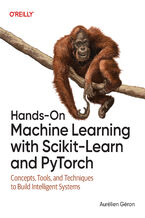 The potential of machine learning today is extraordinary, yet many aspiring developers and tech professionals find themselves daunted by its complexity. Whether you're looking to enhance your skill set and apply machine learning to real-world projects or are simply curious about how AI systems function, this book is your jumping-off place. With an
The potential of machine learning today is extraordinary, yet many aspiring developers and tech professionals find themselves daunted by its complexity. Whether you're looking to enhance your skill set and apply machine learning to real-world projects or are simply curious about how AI systems function, this book is your jumping-off place. With an-
- ePub + Mobi 254 pkt
(245,65 zł najniższa cena z 30 dni)
254.15 zł
299.00 zł (-15%) -
-
Promocja
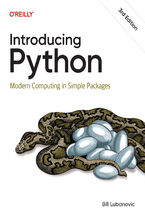 Stuck in a coding conundrum? Whether you're an advanced beginner, an intermediate developer, or a curious newcomer, the complexities of coding can often feel like a labyrinth with no exit. With Python, however, you can start writing real code quickly—but where should you start? In this updated third edition, Bill Lubanovic acts as your personal gu
Stuck in a coding conundrum? Whether you're an advanced beginner, an intermediate developer, or a curious newcomer, the complexities of coding can often feel like a labyrinth with no exit. With Python, however, you can start writing real code quickly—but where should you start? In this updated third edition, Bill Lubanovic acts as your personal gu-
- ePub + Mobi 143 pkt
(29,90 zł najniższa cena z 30 dni)
143.65 zł
169.00 zł (-15%) -
-
Promocja
 AI-assisted coding and cloud-based tools are already transforming how modern applications are built. Bolt.new, a powerful in-browser AI agent from StackBlitz, streamlines the development process, allowing you to prototype quickly, debug intelligently, and launch confidently—no local setup required. Whether you're new to full stack development or lo
AI-assisted coding and cloud-based tools are already transforming how modern applications are built. Bolt.new, a powerful in-browser AI agent from StackBlitz, streamlines the development process, allowing you to prototype quickly, debug intelligently, and launch confidently—no local setup required. Whether you're new to full stack development or lo-
- ePub + Mobi 169 pkt
(29,90 zł najniższa cena z 30 dni)
169.14 zł
199.00 zł (-15%) -
-
Promocja
 AI is transforming software development, shifting programmers from writing code to collaborating with AI in an intent-driven workflow. Vibe coding—a prompt-first, exploratory approach where you describe what you want in natural language and let a large language model fill in the blanks—represents a radical shift in the developer's role from writing
AI is transforming software development, shifting programmers from writing code to collaborating with AI in an intent-driven workflow. Vibe coding—a prompt-first, exploratory approach where you describe what you want in natural language and let a large language model fill in the blanks—represents a radical shift in the developer's role from writing-
- ePub + Mobi 203 pkt
(29,90 zł najniższa cena z 30 dni)
203.15 zł
239.00 zł (-15%) -
-
Promocja
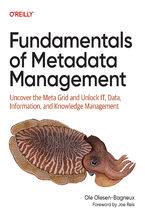 Whether it's to adhere to regulations, access markets by meeting specific standards, or devise data analytics and AI strategies, companies today are busy implementing metadata repositories—metadata tools about the data, information, and knowledge in your company. Until now, most of these repositories have been implemented in isolation from one anot
Whether it's to adhere to regulations, access markets by meeting specific standards, or devise data analytics and AI strategies, companies today are busy implementing metadata repositories—metadata tools about the data, information, and knowledge in your company. Until now, most of these repositories have been implemented in isolation from one anot-
- ePub + Mobi 228 pkt
(29,90 zł najniższa cena z 30 dni)
228.65 zł
269.00 zł (-15%) -
-
Promocja
 In today's environment of partial attention and isolating remote work, few things are more satisfying than group experiences that produce powerful, meaningful connections and output. But this kind of enlivening, collective work doesn't happen by chance. It must be consciously designed and purposefully activated--;in a team, an organization, and a c
In today's environment of partial attention and isolating remote work, few things are more satisfying than group experiences that produce powerful, meaningful connections and output. But this kind of enlivening, collective work doesn't happen by chance. It must be consciously designed and purposefully activated--;in a team, an organization, and a c-
- ePub + Mobi 143 pkt
(29,90 zł najniższa cena z 30 dni)
143.65 zł
169.00 zł (-15%) -
-
Promocja
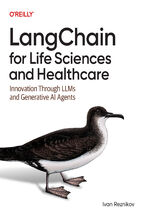 Feeling overwhelmed by the volume of data in your research? Sifting through massive amounts of data to find useful insights is becoming increasingly difficult in drug discovery, genetics, and healthcare. Enter the era of generative AI with LangChain, whose groundbreaking tools are changing the way life scientists and researchers operate. In this g
Feeling overwhelmed by the volume of data in your research? Sifting through massive amounts of data to find useful insights is becoming increasingly difficult in drug discovery, genetics, and healthcare. Enter the era of generative AI with LangChain, whose groundbreaking tools are changing the way life scientists and researchers operate. In this g-
- ePub + Mobi 228 pkt
(29,90 zł najniższa cena z 30 dni)
228.65 zł
269.00 zł (-15%) -
-
Promocja
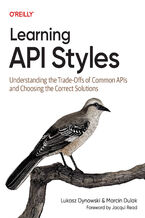 An application programming interface (API) enables data exchange in systems such as web applications, microservices, and IoT devices. In this hands-on book, authors Lukasz Dynowski and Marcin Dulak show software developers and architects how to design and implement REST, GraphQL, gRPC, webhooks, WebSocket, messaging APIs, and more. This book look
An application programming interface (API) enables data exchange in systems such as web applications, microservices, and IoT devices. In this hands-on book, authors Lukasz Dynowski and Marcin Dulak show software developers and architects how to design and implement REST, GraphQL, gRPC, webhooks, WebSocket, messaging APIs, and more. This book look-
- ePub + Mobi 203 pkt
(29,90 zł najniższa cena z 30 dni)
203.15 zł
239.00 zł (-15%) -
-
Promocja
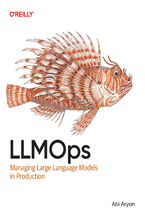 Here's the thing about large language models: they don't play by the old rules. Traditional MLOps completely falls apart when you're dealing with GenAI. The model hallucinates, security assumptions crumble, monitoring breaks, and agents can't operate. Suddenly you're in uncharted territory. That's exactly why LLMOps has emerged as its own disciplin
Here's the thing about large language models: they don't play by the old rules. Traditional MLOps completely falls apart when you're dealing with GenAI. The model hallucinates, security assumptions crumble, monitoring breaks, and agents can't operate. Suddenly you're in uncharted territory. That's exactly why LLMOps has emerged as its own disciplin-
- ePub + Mobi 228 pkt
(29,90 zł najniższa cena z 30 dni)
228.65 zł
269.00 zł (-15%) -
-
Promocja
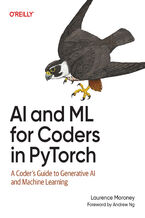 Eager to learn AI and machine learning but unsure where to start? Laurence Moroney's hands-on, code-first guide demystifies complex AI concepts without relying on advanced mathematics. Designed for programmers, it focuses on practical applications using PyTorch, helping you build real-world models without feeling overwhelmed.From computer vision an
Eager to learn AI and machine learning but unsure where to start? Laurence Moroney's hands-on, code-first guide demystifies complex AI concepts without relying on advanced mathematics. Designed for programmers, it focuses on practical applications using PyTorch, helping you build real-world models without feeling overwhelmed.From computer vision an-
- ePub + Mobi 228 pkt
(29,90 zł najniższa cena z 30 dni)
228.65 zł
269.00 zł (-15%) -
Dzięki opcji "Druk na żądanie" do sprzedaży wracają tytuły Grupy Helion, które cieszyły sie dużym zainteresowaniem, a których nakład został wyprzedany.
Dla naszych Czytelników wydrukowaliśmy dodatkową pulę egzemplarzy w technice druku cyfrowego.
Co powinieneś wiedzieć o usłudze "Druk na żądanie":
- usługa obejmuje tylko widoczną poniżej listę tytułów, którą na bieżąco aktualizujemy;
- cena książki może być wyższa od początkowej ceny detalicznej, co jest spowodowane kosztami druku cyfrowego (wyższymi niż koszty tradycyjnego druku offsetowego). Obowiązująca cena jest zawsze podawana na stronie WWW książki;
- zawartość książki wraz z dodatkami (płyta CD, DVD) odpowiada jej pierwotnemu wydaniu i jest w pełni komplementarna;
- usługa nie obejmuje książek w kolorze.
Masz pytanie o konkretny tytuł? Napisz do nas: sklep@ebookpoint.pl
Książka drukowana


Postaraj się złożyć zamówienie do godziny 13:00, w dniach:
18. grudnia (Poczta Polska),
19. grudnia (Paczka w Ruchu),
22. grudnia (paczkomaty InPost),
22. grudnia (DPD punkty).
22. grudnia (DPD Kurier).







Oceny i opinie klientów: SSH, The Secure Shell: The Definitive Guide. The Definitive Guide. 2nd Edition Daniel J. Barrett, Richard E. Silverman, Robert G. Byrnes
(0)